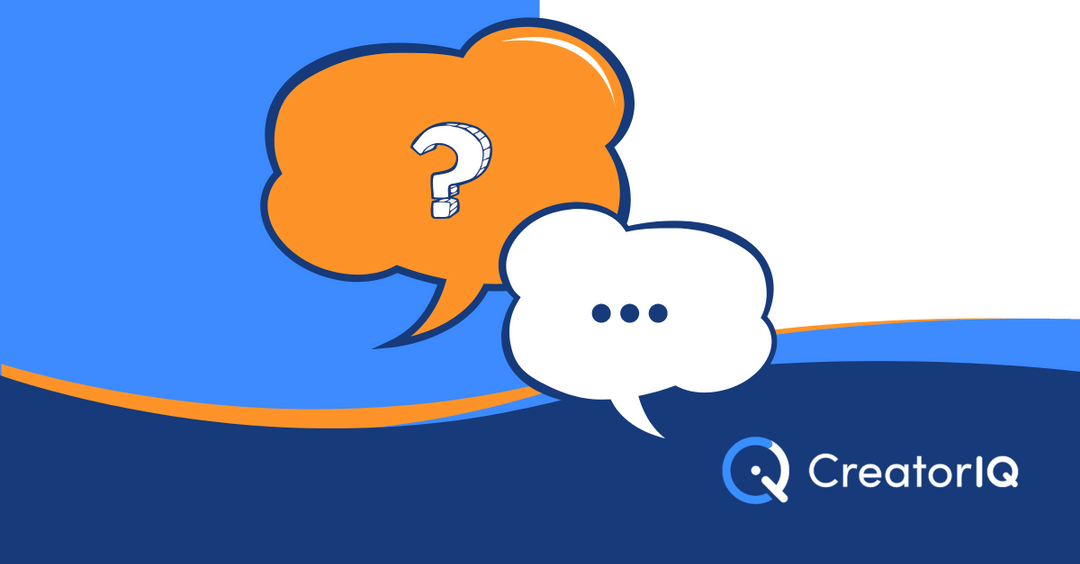Marketing Directors, Sr. Managers and others leading marketing teams are constantly under pressure to improve campaign performance while reducing inefficiencies (all while reporting results concisely to CMOs and other executives). Without a decisive approach to campaign analysis, this can be time-consuming work, and carries a risk of letting key learnings fall through the cracks. In this article, we’d like to help marketers organize their line of questioning to ensure that their teams are taking full advantage of the insights and outcomes being driven by their campaigns.
Here are 9 questions to ask your marketing team about their influencer marketing campaign performance:
1. Based on our goals for this campaign, what are our totals and the percentage we either overperformed or underperformed for each one?
Influencer marketing has become a key channel for any part of the funnel - from awareness to conversions to advocacy. As a marketing leader, you should lean into this full-funnel paradigm and challenge your team’s understanding of metrics that impact your goals. Understanding which metrics are growing and which metrics have decreased can tell a story about your campaign’s performance. For example, perhaps one of your creators is showing a high clickthrough rate, but low on-site conversions. This could mean that, while the content is appealing and engaging to the audience, perhaps the call-to-action needs to be more clear in the copy; this can be easily resolved. As a second example, let’s say that you have a creator who is underperforming in conversions and engagement. This creator is probably not the best fit for your brand, and by understanding their conversion totals you will know not to work with them on this kind of campaign again. By challenging your team to think about which creators are performing best, you are more likely improve the health of your influencer marketing program by creating a data-centric approach to campaign analysis within your team.
Related: If you need guidance setting goals or selecting KPIs, read our article, “ Key Influencer Marketing Metrics to Track (+Cheat Sheet).”
2. Does our influencers’ performance align with the 90-day performance averages found in their creator profiles?
Influencer marketing software lets you review a creator’s historical performance data, allowing you to make an informed decision on whether to work with them or not. Sometimes, however, a creator’s performance will under or over perform your projections based on this data. It’s important that your marketing team compares your creators’ campaign performance with their average platform performance. If your creators are performing worse than their average, this can signal an issue in strategy, content, or messaging.
3. What are we doing with our highest and lowest performing creators?
One of the effective ways to optimize campaign performance and set up successful campaigns in the future is to have a strategy for low and high-performing creators. Analyze the performance of your creators and consider removing ones who consistently underperform, while developing a deeper relationship with high performers so they are likely to work with you again or advocate for your brand organically. For example, why send products to 200 creators every month when you can send it to your top 50 and perform just as well? Save the time and resources.
4. What is it about our top performing content that works? Is it the style of the post, the caption and keywords, the product itself, or what the creator stands for?
It’s important to know what exactly makes certain creators high performers - not everyone drives engagements the same way, for the same reasons. Some content resonates because of aesthetic appeal, some creators personally engage more with their audiences, and some stand for causes that audiences care about. Some simply know how to use the social media platforms’ algorithms to their advantage. Find out why your creators perform well and grow your strategy with those factors in mind.
5. Which content types drive the best results for our brand?
Instagram in-feed and stories are currently the most popular content types that brands are interested in tracking, but they’re not always the best-performing channels. Audiences of fashion brands may resonate more with beautifully curated still pics, while beauty brand audiences typically care more about video tutorials, reviews, and long-form content. Know what works best for your brand while still experimenting with channel and formats.
6. Are we using audience demographic data to reach our target audience?
Does your team begin their search by focusing on 'creator attributes' instead of 'audience attributes' when searching for creators? Don’t make this mistake. You will likely find more success if your creator’s audience matches your consumer profile, rather than the creator themselves. Follow the right audience and the right creators will surface during your search.
Here are a few steps your team can use to target your target audience with demographic and psychographic data:
- In your search, apply demographic filters (location, age, gender, ethnicity); be as specific as your profiles require
- In the same tool, check for “affinities” to apply psychographic data to your search. Including audiences with an affinity for competitor brands, for example, lets you target audiences with a particular interest in your category - think of them as “in-market” audiences that you can tap into with your campaigns
- Finally, use a Creator Comparison & Recommendations tool to scale recruitment and save time. The tool leverages CreatorIQ’s immense historic creator and campaign performance data to compare creators and identify lookalike creators that are an ideal fit for your brand or campaign!
Pro-Tip: use the CreatorIQ Active Audience Score tool to apply a minimum “Instagram Active Audience” score of 75% - this will help you ensure that your creator’s audience is legitimate and engaged.
7. What emerging social media trends can we tap into to improve campaign performance?
Stay ahead of the trends! For example, if your campaign goal is sales conversions, press your team on which shoppable social features they are incorporating into their strategies to improve conversion efficiencies. Have they considered Instagram’s “Drops” feature, or Pinterest’s “Shopping List”? Pay attention and try new things. The last thing you want is for your brand to be on the tail end of a trend, playing catch up while your competitors capture market share.
8. How does our performance compare to our competitors?
Analyze creators that are driving high performance for your competitors. Find out what’s working for them, what's not working for them and apply the learnings to your own strategy.
Pro-Tip: using CreatorIQ, you can pull data on every public social media profile in the world, giving you insight into your competitors’ influencer marketing campaign performance.
9. What are we doing to turn our top performing creators into brand advocates?
There is a correlation between creators’ perception of a brand and their performance. If a creator dislikes a brand or had a poor experience, they may ignore outreach and potentially accept exclusivity with a direct competitor. On the other hand, if a brand elevates creators’ experiences, the creators may go above and beyond for the brand.
Get your team thinking about how they continue to nurture relationships with top performing creators. Are they inviting them to exclusive events? Are they sending them a birthday card or gift? Or are they shouting them out on your brand’s channels? When creators become true brand advocates, they will talk highly about your brand even when you don’t ask them to.
To learn more about CreatorIQ’s platform capabilities, watch our Product Demo video now!

